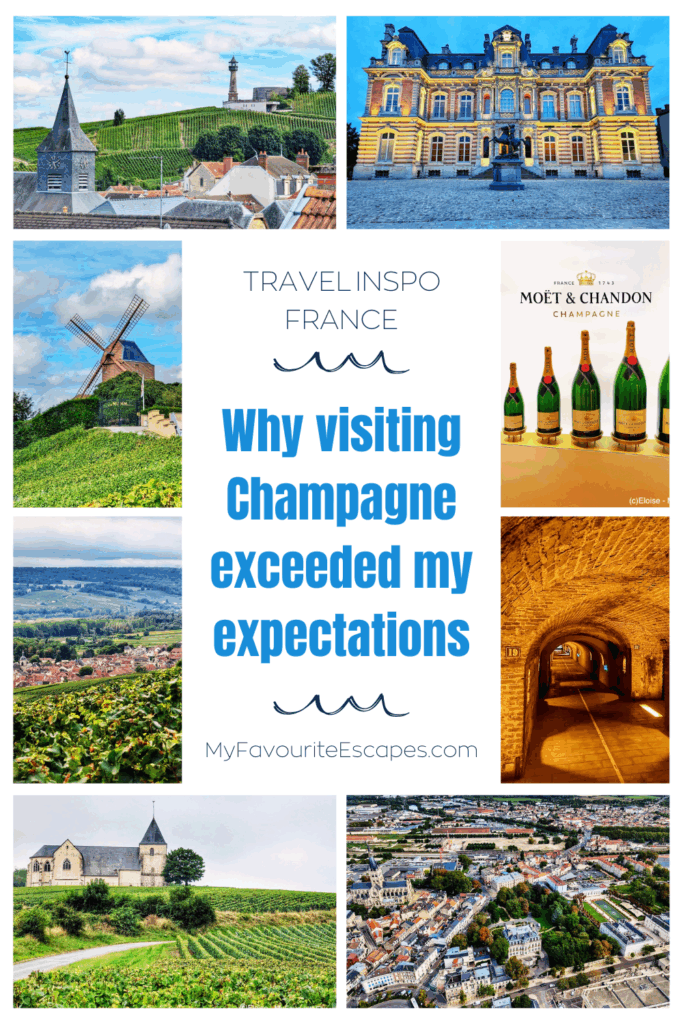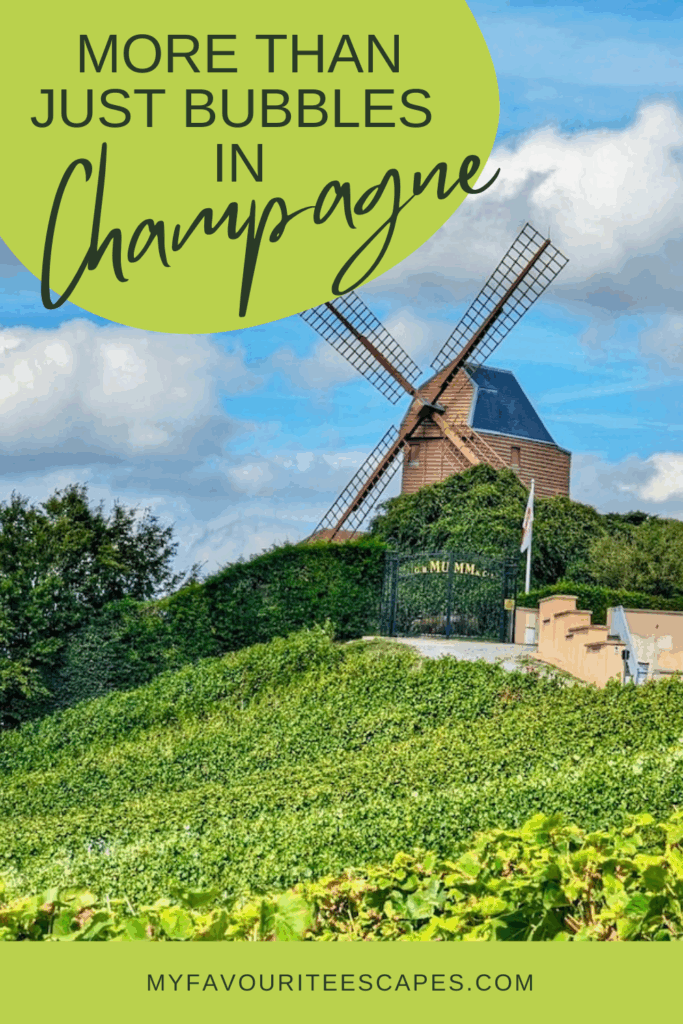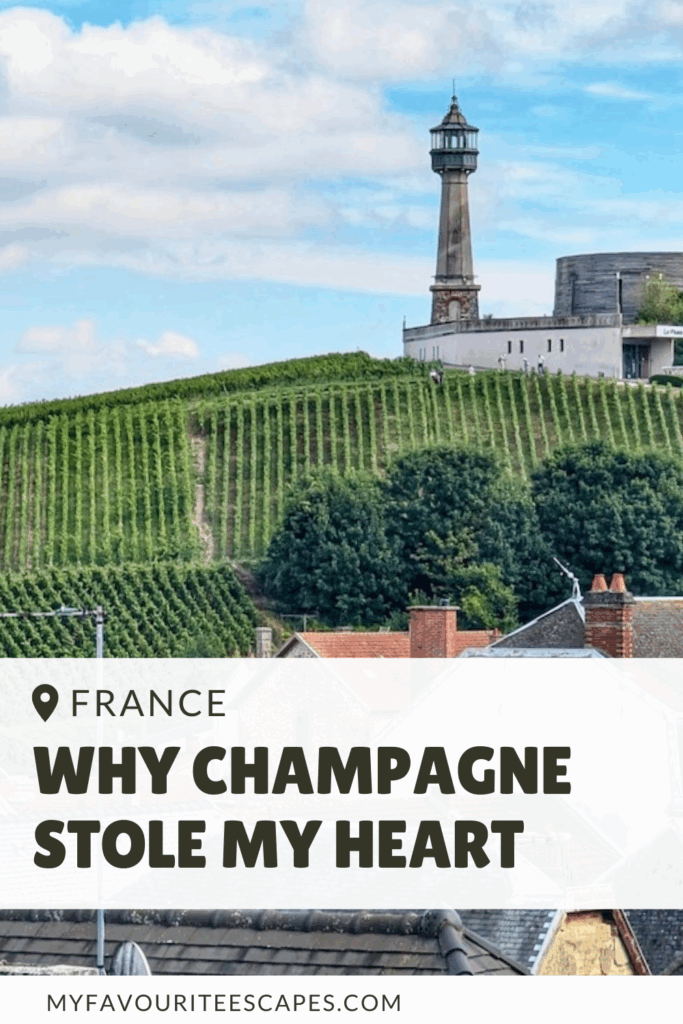Before planning our trip, I wondered if Champagne was worth visiting. And I really don’t regret our decision to spend three days in the region as it ended up surpassing my expectations. Find out why as I go through the reasons I initially hesitated, and what ultimately made Champagne a highlight of our itinerary.

All Champagne taste the same? Not even close!
One of my biggest initial concerns was that the whole trip might revolve around tasting the same type of wine. I’ve always loved drinking champagne, but I assumed they all tasted more or less the same. I couldn’t have been more wrong.
There’s so much more variety in this type of sparkling wine than I ever realised. I learned that Blanc de Blancs, made exclusively from Chardonnay grapes, delivers fresh, crisp citrus notes, while Blanc de Noirs, produced from Pinot Noir or Pinot Meunier grapes, is richer, with deeper red fruit flavors. This contrast made each tasting exciting, as every champagne house offered different styles. We tried everything from fruity and floral to mineral and nutty champagnes, and it was fascinating to explore how these flavours are shaped by the blend of grapes and the winemaking process.
Even more intriguing was Millésime champagne, which is made only in exceptional years from a single harvest. Tasting vintage champagne that reflected a particular year’s growing conditions and weather was an experience in itself, adding a whole new layer of appreciation for this drink.



The Champagne region can hold its own against France’s more popular destinations
I’ll admit, when we first planned our trip to France, I didn’t think Champagne could compete with the beauty of other regions like Provence, Brittany or the Alps. I was worried the experience might not live up to the rich culture, stunning scenery and diverse activities that many areas in France are known for. But Champagne surprised me with unique, one-of-a-kind experiences I couldn’t have found anywhere else, and it surely deserves its spot on the best wine regions to visit in France.
In Épernay, we had the unforgettable experience of taking a ride in a captive balloon to admire the elegant champagne houses in the town surrounded by vineyards from up in the air. Then there was the quirky Verzenay Lighthouse, an inland landmark standing among a sea of vineyards. It was so unexpected, adding a touch of charm to the region. And nearby, we discovered the Faux de Verzy, a mystical forest filled with rare, twisted dwarf beech trees that looked like leaf igloos straight out of a fairy tale and made a lovely nature break.
We didn’t have time for it, but there’s also an opportunity to cruise among the vineyards on a solar boat* in Ay.




Champagne isn’t just about drinking; there’s plenty of culture, history and beautiful landscapes
Beyond the champagne itself, the region offers a lot to explore. Reims is a city full of history, including the famous Reims Cathedral where French kings were crowned. The history and grandeur of this place add a whole new dimension to a Champagne itinerary.

If you have limited time and are hesitating between visiting Reims or Epernay, read this.
There are also beautiful landscapes and charming villages to enjoy, such as Hautvillers, known as the birthplace of champagne where Dom Pérignon is said to have perfected the champagne-making process, and the church of Chavot-Courcourt surrounded by rolling hills of vineyards. The scenery alone is enough to justify a visit, even if champagne wine isn’t the main draw for you.




Finally, Troyes, in the southern part of the Champagne region, transported us back in time with its medieval architecture, narrow cobblestone streets, and half-timbered houses. The stunning churches, the beautifully preserved old town and the fascinating museums make it a perfect stop for anyone looking to experience more than just wine.





Champagne isn’t about luxury and exclusivity; it’s easy and accessible for everyone
I used to think Champagne was all about exclusivity and high-end luxury, catering to travellers seeking opulence and glamour. While it’s true that there are grand, lavish champagne houses like Moët et Chandon and Veuve Clicquot, which offer elegant, polished experiences, I quickly realised there’s so much more to Champagne than just luxury.
Yes, the big champagne houses are impressive with their large cellars and refined atmospheres, but you can also visit smaller, family-run producers that offer a much more personal and relaxed experience. Some of these places don’t even require an appointment, and we were welcomed warmly everywhere we went, even at some of the more fancy places. It may feel touristy at times, but it never felt exclusive or too snobbish.
For those who don’t speak French or prefer not to drive (you shouldn’t drink and drive!), joining a tour* makes the trip effortless and is an excellent way to explore the region. The tours are well-organised, taking you through picturesque vineyards, and guides are accommodating for international visitors. That said, having a car gave us the freedom to take scenic drives through the stunning countryside, but it wasn’t essential. Whether on a tour or on our own, Champagne was incredibly easy and welcoming to explore – much more accessible than I had expected.





Plus: Champagne is easy to get to
Getting to Champagne from Paris is incredibly straightforward. The high-speed TGV train connects Paris to Reims in about 45 minutes, making it a perfect destination for a day trip or a longer stay. Epernay is also accessible by train and so is Troyes.
If you prefer the flexibility of driving, renting a car will allow you to explore the scenic routes through the vineyards at your own pace, with plenty of picturesque stops along the way. But if you plan on drinking, joining a tour is the best option. You’ll find tours from Reims*, Epernay* and even Paris*.
Conclusion: Champagne is so much more than I expected
In the end, Champagne offered a perfect balance between luxury and authenticity, wine tasting and history, grand experiences and hidden gems. It surpassed all my expectations and showed me that it’s not just for luxury travelers or champagne connoisseurs – it’s for anyone who appreciates culture, beautiful landscapes, wine of course, and unique experiences.
So, is it worth visiting Champagne? Absolutely! A trip to Champagne is easy to organise and whether you’re drawn by the history, the wine, or the scenery, this region has something to offer everyone, and it might just surprise you the way it did me.

Where is Champagne and where to stay in Champagne
Champagne offers a variety of accommodations, from luxury hotels and chateaux (check out Le Château d’Etoges* and Chateau de Sacy* for a very special stay or Le 25bis by Leclerc Briant* in Epernay), charming bed-and-breakfasts, or even stays at a vineyard for stunning views (like this one north of Reims*).
Reims (often with cheaper options*) and Épernay are the most popular bases, with easy access to the major champagne houses, but staying in one of the smaller villages can give you a more intimate experience of the region.
Do you think Champagne is worth visiting? Share your experience in the comments below!
Save this article about visiting Champagne for later!
Planning a trip to France? Save this article about visiting Champagne on Pinterest to find it easily later!




